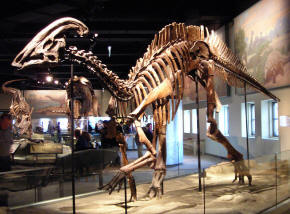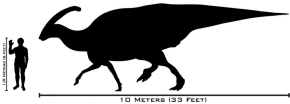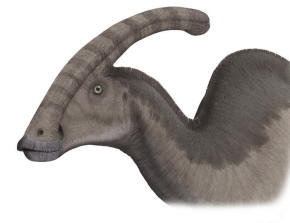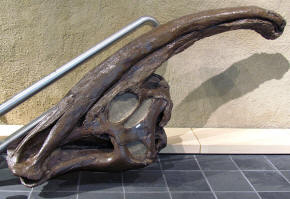|
Description
As is the case with most dinosaurs, the skeleton of
Parasaurolophus
is incompletely known. The length of the
type specimen of P. walkeri is estimated at 9.5 meters (31
ft). Its skull is about 1.6 meters (5.2 ft) long, including the crest,
whereas the type skull of
P. tubicen is over 2.0
meters (6.6 ft) long, indicating a larger animal. Its weight is estimated at
2.7 tons).
Its single known forelimb was relatively short for a hadrosaurid, with a
short but wide
shoulder
blade. The thighbone measures 103 centimeters (3.38 ft) long in
P. walkeri
and is robust for its length when compared to other hadrosaurids. The
upper arm
and pelvic
bones were also heavily built.
Like other hadrosaurids, it was able to walk on either two legs or four.
It probably preferred to forage for food on four legs, but ran on two. The
neural spines of the
vertebrae were tall, as was common in lambeosaurines; tallest over the
hips, they increased the height of the back.
Skin impressions are known for
P. walkeri, showing uniform
tubercle-like scales but no larger structures.
The most noticeable feature was the cranial crest, which protruded from
the rear of the head and was made up of the
premaxilla and
nasal
bones. The P. walkeri type specimen has a notch in the neural
spines near where the crest would hit the back, but this may be a
pathology
peculiar to this individual. William Parks, who named the genus,
hypothesized that a
ligament
ran from the crest to the notch to support the head. Although this idea
seems unlikely, Parasaurolophus is sometimes restored with a skin
flap from the crest to the neck. The crest was hollow, with distinct tubes
leading from each nostril to the end of the crest before reversing direction
and heading back down the crest and into the skull. The tubes were simplest
in P. walkeri, and more complex in
P. tubicen, where some
tubes were blind and others met and separated. While
P. walkeri and
P. tubicen had long crests with only slight curvature,
P.
cyrtocristatus had a short crest with a more circular profile.
Classification
As its name implies,
Parasaurolophus was initially thought to be
closely related to
Saurolophus because of its superficially similar crest. However, it
was soon reassessed as a member of the
lambeosaurine subfamily of hadrosaurids—Saurolophus is an
hadrosaurine. It is usually interpreted as a separate offshoot of the
lambeosaurines, distinct from the helmet-crested
Corythosaurus,
Hypacrosaurus, and
Lambeosaurus. Its closest known relative appears to be
Charonosaurus, a lambeosaurine with a similar skull (but no complete
crest yet) from the
Amur
region of northeastern China, and the two may form a
clade
Parasaurolophini. P. cyrtocristatus, with its short, rounder crest,
may be the most
basal of the three known
Parasaurolophus species, or it may
represent
subadult or female specimens of
P. tubicen.
Species
The
type species P. walkeri, from Alberta, is known from a single
definitive specimen from the
Dinosaur Park Formation, though others from the Dinosaur Park probably
belong to it. It differs from P. tubicen by having simpler tubes in
its crest, and from P. cyrtocristatus by having a long, unrounded
crest and a longer
upper arm
than
forearm. It lived between 76.5 and 75.3 million years ago.
P. tubicen, from New Mexico, is known from the remains of at least
three individuals. It is the largest species, with more complex air passages
in its crest than P. walkeri, and a longer, straighter crest than
P. cyrtocristatus.
P. tubicen is known only from the De-na-zin
Member of the
Kirtland Formation, and lived about 73.4-73 million years ago, making it
the most recent species.
P. cyrtocristatus, from the
Kaiparowits and
Fruitland Formations of New Mexico and Utah, is known from three
possible specimens. It lived 75.5-74.5 million years ago, and is the
smallest species, with a short rounded crest. Its small size and the form of
its crest have led several scientists to suggest that it represents
juveniles or females of P. tubicen, though
P. tubicen lived at
least one million years later. As noted by Thomas Williamson, the type
material of P. cyrtocristatus is about 72% the size of
P. tubicen,
close to the size at which other lambeosaurines are interpreted to begin
showing definitive
sexual dimorphism in their crests (~70% of adult size). However, this
position has been rejected in recent reviews of lambeosaurines.
Paleoecology
Parasaurolophus walkeri, from the
Dinosaur Park Formation, was a member of a diverse and well-documented
fauna of
prehistoric animals, including well-known dinosaurs such as the
horned
Centrosaurus and
Chasmosaurus; fellow duckbills
Gryposaurus and
Corythosaurus;
tyrannosaurid
Gorgosaurus; and
armored
Edmontonia,
Euoplocephalus and
Dyoplosaurus. It was a rare constituent of this fauna. The Dinosaur
Park Formation is interpreted as a low-relief setting of
rivers and
floodplains that became more
swampy and
influenced by marine conditions over time as the
Western Interior Seaway
transgressed westward.
In New Mexico and Utah, the species
P. cyrtocristatus shared its
environment with the horned ceratopsians
Utahceratops,
Kosmoceratops, and
Pentaceratops, and the
coelurosaur
Ornithomimus, and the tyrannosaur
Teratophoneus.
The last and largest of the
Parsaurolophus species,
P. tubicen,
lived in New Mexico alongside the large
sauropod
Alamosaurus, duckbill
Kritosaurus, horned
Pentaceratops, armored
Nodocephalosaurus,
Saurornitholestes, and the
tyrannosaurid
Bistahieversor. The Kirtland Formation is interpreted as river
floodplains appearing after a retreat of the Western Interior Seaway.
Conifers were the dominant plants, and
chasmosaurine horned dinosaurs were apparently more common than
hadrosaurids.
Paleobiology
Feeding
As a hadrosaurid,
Parasaurolophus was a large bipedal/quadrupedal
herbivore, eating plants with a sophisticated skull that permitted a grinding motion
analogous to
chewing. Its teeth were continually replacing and packed into dental batteries that
contained hundreds of teeth, only a relative handful of which were in use at
any time. It used its beak to crop plant material, which was held in the
jaws by a cheek-like
organ. Feeding would have been from the ground up to around 4 meters (13 ft)
above. As noted by
Bob Bakker, lambeosaurines have narrower beaks than hadrosaurines,
implying that Parasaurolophus and its relatives could feed more
selectively than their broad-beaked, crestless counterparts.
Cranial crest
Many hypotheses have been advanced as to what functions the cranial crest
of Parasaurolophus performed, but most have been discredited. It is
now believed that it may have had several functions: visual display for
identifying species and sex, sound amplification for communication, and
thermoregulation. It is not clear which was most significant at what times
in the evolution of the crest and its internal nasal passages.
Differences between species and growth stages
As for other lambeosaurines, it is believed that the cranial crest of
Parasaurolophus changed with age and was a
sexually dimorphic characteristic in adults.
Recent restudy of a juvenile braincase previously
assigned to
Lambeosaurus, now assigned to
Parasaurolophus,
provides evidence that a small tubular crest was present in juveniles.
Social functions
Instead, social and
physiological functions have become more supported as function(s) of the
crest, focusing on
visual and
auditory identification and communication. As a large object, the crest
has clear value as a visual signal, and sets this animal apart from its
contemporaries. The large size of hadrosaurid
eye sockets and the presence of
sclerotic rings in the eyes imply acute vision and
diurnal
habits, evidence that sight was important to these animals. If, as is
commonly illustrated, a skin frill extended from the crest to the neck or
back, the proposed visual display would have been even showier. As is
suggested by other lambeosaurine skulls, the crest of
Parasaurolophus
likely permitted both species identification (such as separating it from
Corythosaurus or
Lambeosaurus) and sexual identification by shape
and size.
Sounding function
However, the external appearance of the crest does not correspond to the
complex internal anatomy of the nasal passages, which suggests another
function accounted for usage of the internal space. Carl Wiman was the first
to propose, in 1931, that the passages served an auditory signaling
function, like a
crumhorn;
Hopson and David B. Weishampel revisited this idea in the 1970s and 1980s.
Hopson found that there is anatomical evidence that hadrosaurids had strong
hearing. There is at least one example, in the related
Corythosaurus,
of a slender
stapes (reptilian ear bone) in place, which combined with a large space
for an eardrum implies a sensitive
middle
ear. Furthermore, the hadrosaurid
lagena is
elongate like a
crocodilian's, indicating that the auditory portion of the
inner ear
was well-developed. Weishampel suggested that
P. walkeri was able to
produce frequencies of 48 to 240
Hz, and
P.
cyrtocristatus (interpreted as a juvenile crest form) 75 to 375 Hz.
Based on similarity of hadrosaurid
inner
ears to those of
crocodiles, he also proposed that adult hadrosaurids were sensitive to
high frequencies, such as their offspring might produce. According to
Weishampel, this is consistent with parents and offspring communicating.
Computer modeling of a well-preserved specimen of
P. tubicen, with
more complex air passages than those of P. walkeri, has allowed the
reconstruction of the possible sound its crest produced. The main path
resonates at around 30 Hz, but the complicated sinus anatomy causes peaks
and valleys in the sound.
Cooling function
The large surface area and
vascularization of the crest also suggests a thermoregulatory function.
P.E. Wheeler first suggested this use in 1978 as a way to keep the
brain cool.
Teresa Maryańska and Osmólska also proposed thermoregulation at about
the same time, and Sullivan and Williamson took further interest. David
Evans' 2006 discussion of lambeosaurine crest functions was favorable to the
idea, at least as an initial factor for the evolution of crest expansion.
If you ordered the Test Pack, it is now time to
take Test 9.
Return to the
Old Earth Ministries Online Dinosaur
Curriculum homepage.
|



